List of rulers of Croatia
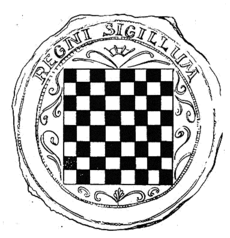
.svg.png)
History
The details of the arrival of the Croats are scarcely documented: c.626, Croats migrate from White Croatia (around what is now Galicia) at the invitation of Eastern Roman Emperor Heraclius. Between c. 641 and c. 689 Radoslav converts Croatia to Christianity.
Dukes of Croatia
During 8th century two principalities were formed - the Pannonian Croatia and the Dalmatian Croatia, with two parallel dukes on rule.
Dukes of the Pannonian Croatia
| Portrait | Ruler | Began | Ended | Remarks |
|---|---|---|---|---|
| Vojnomir | 791 | c. 810 | ||
| Ljudevit Posavski | c. 810 | 823 | ||
| Ratimir | 829 | 838 | ||
| Braslav | 880 | 887 |
Dukes of the Dalmatian Croatia
| Portrait | Ruler | Began | Ended | Remarks |
|---|---|---|---|---|
| Borna | ... | ... | ||
| Radoslav | ... | ... | ||
| Kuber | ... | ... | ||
| Porga or Borko | 660 | 680 | ||
| Budimir | 740 | 785 | ||
| Višeslav | 785 | 802 | ||
.JPG) | Borna | 810 | 821 | Vassal of Frankish Emperor Charlemagne; son of Višeslav |
| Vladislav | January 821 | 835 | son of Klonimir | |
| Mislav | 835 | 845 | ||
| Trpimir I | 845 | 864 | Founder of the Trpimirović dynasty | |
| Zdeslav | 864 | 864 | son of Trpimir I | |
| Domagoj | 864 | 876 | overthrows his cousin Zdeslav | |
| Iljko ? | 876 | 878 | Iljko's name is disputed, it is only known that he was a son of Domagoj, killed during a civil war | |
| Zdeslav | 878 | May 879 | restored | |
 | Branimir | 879 | 892 | son of Domagoj |
| Muncimir | 892 | 910 | son of Trpimir | |
 | Tomislav | 910 | 928 | |
Kings of Croatia
In his letter from 925, Pope John X refers to Tomislav as Rex Chroatorum - King of the Croatians. All Croatian rulers after Tomislav held the title of king.
House of Trpimirović
| Portrait | Ruler | Began | Ended | Remarks |
|---|---|---|---|---|
 | Tomislav | 925 | 928 | Probably son of Muncimir. After his death civil wars weakened the state and some territory, including Bosnia, was lost. His rank of "king" (rex) is based on two contemporary documents; a correspondence dated 925 where the Pope John X addresses him with that title and the transcript from the Synod conclusions in Split where he is also referred to as "rex". He was also addressed as "Princeps" ("Prince") and Duke (Dux) on other occasions. Nevertheless, in Croatia he is traditionally considered the first Croatian king. |
| | Trpimir II | 928 | 935 | Younger brother or son of Tomislav |
| | Krešimir I (Krešimir Stariji) | 935 | 945 | Son of Trpimir II |
| | Miroslav | 945 | 949 | Son of Krešimir I |
| | Michael Krešimir II (Mihovil Krešimir II) and Helen I (Jelena Zadarska) (co-rulers) | 949 | 969 | Younger brother of Miroslav. Michael Krešimir II ruled jointly with his wife Queen Helen I. Upon the King's death in 969 their son Stephen Držislav immediately took the throne alone, while the Queen Helen I died seven years later on 8 October 976. During their reign, the Croatian Kingdom regained previously lost territories, including Bosnia. |
| | Stephen Držislav (Stjepan Držislav) | 969 | 997 | Son of Michael Krešimir II. Queen Jelena of Zadar ruled as a regent for Stephen Držislav 969 - 8 November 975. He received royal insigia as an act of recognition from the Byzantine Emperor and was crowned by the Archbishop of Split in Biograd in 988. Thomas the Archdeacon's Historia Salonitana names him as the first King of Croatia (rex), regardless, he is considered the first crowned Croatian King.[1] |
| | Svetoslav Suronja | 997 | 1000 | Son of Stephen Držislav. Detroned by his brothers Krešimir III and Gojslav |
| | Krešimir III and Gojslav (co-rulers) | 1000 | 1020 | Younger brothers of Svetoslav Suronja |
| | Krešimir III (alone) | 1020 | 1030 | Younger brother of Svetoslav Suronja |
| | Stephen I (Stjepan I) | 1030 | 1058 | Son of Krešimir III |
 | Peter Krešimir IV the Great (Petar Krešimir IV Veliki) | 1058 | 1074 | Son of Stephen I. During his reign the Croatian Kingdom reached its peak. |
 | Demetrius Zvonimir (Dmitar Zvonimir) | 1075 | 1089 | Cousin of Peter Krešimir IV. C. 1063 marries Princess Helen, daughter of King Bela I of Hungary. |
| | Stephen II (Stjepan II) | 1089 | December 1090 | Son of Častimir, who was younger brother of King Peter Krešimir IV. |
| | Helen II (Jelena Lijepa) | 1090 | 1091 | Widow of King Demetrius Zvonimir and daughter of King Bela I of Hungary |
House of Árpád
| Portrait | Ruler | Began | Ended | Remarks |
|---|---|---|---|---|
| | Ladislaus I of Hungary (Ladislav I. Arpadović) | 1091 | 1092 | Son of Hungarian king Béla I and brother of Croatian Queen Jelena Lijepa |
| | Duke Álmos (herceg Almoš) | 1091 | 1093 | Nephew of Ladislaus, rules as his proxy. |
House of Svačić
| Portrait | Ruler | Began | Ended | Remarks |
|---|---|---|---|---|
| | Petar Svačić | 1093 | 1097 | Elected by Croatian nobles. Struggles with Hungary for control of Croatia. From 1097 onwards, the Kings of Hungary were also Kings of Croatia, because of the political union of the two crowns. |
After 1102
From 1102, the reigning King of Hungary is ruler of Kingdom of Croatia-Slavonia and Dalmatia in agreement with the Croatian nobles.[2][3] Croatia is governed on his behalf by a Ban (viceroy) and a Sabor.
House of Árpád
| Portrait | Ruler | Began | Ended | Remarks |
|---|---|---|---|---|
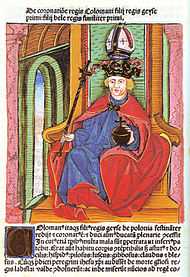 | Coloman (Koloman) | 1102 | 3 February 1116 | Battle of Gvozd Mountain (modern Petrova Gora). Coloman, supported by Pannonian Croats, defeats an army of Croatian and Dalmatian nobles allied to Petar. Recognized as King of Croatia by a council (Sabor) of Croatian nobles. |
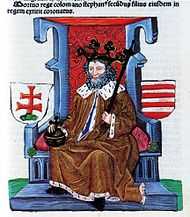 | Stephen III (Stjepan II.) | 3 February 1116 | 3 April 1131 | Son of Coloman |
 | Béla I the Blind (Bela II. Slijepi) | 3 April 1131 | 13 February 1141 | grandson of Géza I, son of Álmos, Coloman's younger brother |
 | Géza (Gejza II.) | 13 February 1141 | 31 May 1162 | son of Béla II |
 | Stephen IV (Stjepan III.) | 31 May 1162 | 4 March 1172 | son of Géza II |
| | Ladislaus II (Ladislav II.) | 31 May 1162 | 14 January 1163 | rebel anti-king, younger brother of Géza II. |
 | Stephen V (Stjepan IV.) | 14 January 1163 | June 1163 | rebel anti-king, younger brother of Géza II. |
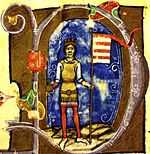 | Béla II | 4 March 1172 | 13 April 1196 | younger brother of Stephen III. |
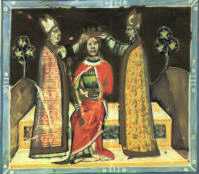 | Emeric (Emerik) | 13 April 1196 | 30 November 1204 | son of Béla III. |
 | Ladislaus III (Ladislav III.) | 30 November 1204 | 7 May 1205 | son of Emerik, crowned and died as a child |
 | Andrew I (Andrija II.) | 7 May 1205 | 21 September 1235 | brother of Emerik, in 1222 issued Golden Bull which established the rights of noblemen, including the right to disobey the King when he acted contrary to law (jus resistendi). |
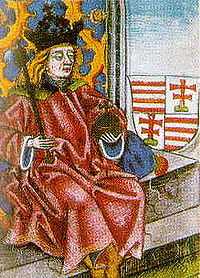 | Béla III | 21 September 1235 | 3 May 1270 | son of Andrew II, ruled during First Mongol invasion (1241–42), in 1242 issued Golden Bull and proclaimed Zagreb and Samobor a Free Royal Borough (free and royal city) |
 | Stephen VI (Stjepan V.) | 3 May 1270 | 6 August 1272 | son of Béla IV. |
 | Ladislaus IV the Cuman (Ladislav IV. Kumanac) | 6 August 1272 | 10 July 1290 | son of Steven V.; unsuccessful Mongol invasion; lived with the nomad Cuman tribes |
 | Andrew II (Andrija III. Mlečanin) | 4 August 1290 | 14 January 1301 | grandson of Andrew II, born in Venice; last of the Árpád dynasty |
House of Anjou
| Portrait | Ruler | Began | Ended | Remarks |
|---|---|---|---|---|
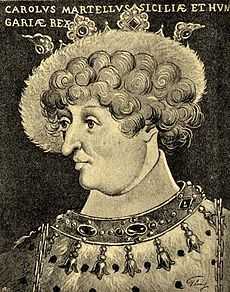 | Charles Martel of Anjou (Karlo Martel) | 1290 | 1295 | set up by Pope Nicholas IV and the ecclesiastical party as successor of his maternal uncle, the childless Ladislaus IV. Crowned as the King of Croatia but not as King of Hungary |
| | Charles I (Karlo I. Robert) | 14 January 1301 | 16 July 1342 | son of Charles Martel, established the royal Angevin dynasty. |
 | Louis I the Great (Ludovik I. Veliki) | 16 July 1342 | 11 September 1382 | also became King of Poland (1370) |
 | Mary I (Marija Anžuvinska) | 11 September 1382 | 17 May 1395 | married Sigismund of Luxemburg |
 | Charles II (Karlo II. Drački) | 31 December 1385 | 24 February 1386 | also King of Naples, in opposition to Mary. Assassinated on 7 February 1386 an died on 24 February |
House of Luxembourg
| Portrait | Ruler | Began | Ended | Remarks |
|---|---|---|---|---|
 | Sigismund I (Žigmund Luksemburški) | 31 March 1387 | 9 December 1437 | later also Roman-German King (since 1410), King of Bohemia (since 1419), Holy Roman Emperor (since 1433) |
House of Anjou
| Portrait | Ruler | Began | Ended | Remarks |
|---|---|---|---|---|
.jpg) | Ladislaus of Naples (Ladislav Napuljski) | 5 August 1403 | 1409 | Son of Charles II. Claimed the Crown of Hungary and Croatia and opposed by King Sigismund of Luxemburg. Ladislas eventually sold his rights to the Venetian Republic for 100,000 ducats in 1409. |
House of Habsburg
| Portrait | Ruler | Began | Ended | Remarks |
|---|---|---|---|---|
 | Albert I | 1 January 1438 | 27 October 1439 | son-in-law of Sigismund, also Roman-German King, King of Bohemia, Duke of Austria |
Jagiellon dynasty
| Portrait | Ruler | Began | Ended | Remarks |
|---|---|---|---|---|
 | Vladislaus I (Vladislav I. Jagelović) | 15 May 1440 | 10 November 1444 | also King of Poland |
House of Habsburg
| Portrait | Ruler | Began | Ended | Remarks |
|---|---|---|---|---|
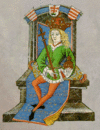 | Ladislaus V the Posthumus (Ladislav V. Posmrtni) | 10 November 1444 | 23 November 1457 | born in 1440 after his father's death, spent most of his life in captivity. |
House of Hunyadi
| Portrait | Ruler | Began | Ended | Remarks |
|---|---|---|---|---|
 | Matthias I Corvinus (Matija Korvin) | 24 January 1458 | 6 April 1490 | son of John Hunyadi, also King of Bohemia |
Jagiellon dynasty
| Portrait | Ruler | Began | Ended | Remarks |
|---|---|---|---|---|
 | Vladislaus II (Vladislav II. Jagelović) | 15 July 1490 | 13 May 1516 | also King of Bohemia |
 | Louis II (Ludovik II.) | 13 May 1516 | 29 August 1526 | also King of Bohemia; killed in the Battle of Mohács |
House of Zápolya
Kingship disputed between Ferdinand of Austria and John Zápolya during the Ottoman invasion
| Portrait | Ruler | Began | Ended | Remarks |
|---|---|---|---|---|
 | John I (Ivan Zapolja) | 10 November 1526 | 22 July 1540 | Also claimed the throne, with support of Hungarian nobles and later Suleiman the Magnificent. |
House of Habsburg
On January 1, 1527 Croatian Parliament, on its session in Cetin elected Ferdinand, Archduke of Austria as the new king of Croatia.
| Portrait | Ruler | Began | Ended | Remarks |
|---|---|---|---|---|
 | Ferdinand I, Holy Roman Emperor (Ferdinand Habsburški) | 16 December 1526 | 25 July 1564 | claimed the throne according the agreement between the House of Jagiellon and the House of Habsburg |
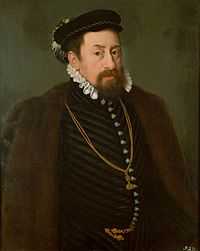 | Maximilian (Maksimilijan I.) | 8 September 1563 | 12 October 1576 | ruled during Battle of Szigetvár and Croatian peasant revolt |
 | Rudolf I | 25 September 1572 | 26 June 1608 | ruled during Battle of Sisak, abdicated in favor of his younger brother Matthias |
 | Matthias II (Matija II.) | 26 June 1608 | 20 March 1619 | brother of Rudolf II |
 | Ferdinand II | 1 July 1618 | 15 February 1637 | In 1630 issued Statuta Valachorum in opposition to Croatian Parliament |
 | Ferdinand III | 8 December 1625 | 2 April 1657 | |
 | Leopold I | 27 June 1657 | 5 May 1705 | Crushed Zrinski–Frankopan Conspiracy and abolished the right of Croatian Parliament to elect king. In 1669 founded University of Zagreb |
 | Joseph I (Josip I.) | 5 May 1705 | 17 April 1711 | |
 | Charles III (Karlo III.) | 11 April 1711 | 20 October 1740 | On 9 March 1712 Croatian Parliament voted its Pragmatic Sanction in which the Kingdom of Croatia accepted female inheritance of its crown after extinction of the male line and supporting her to become Queen of Croatia |
House of Habsburg-Lorraine
| Portrait | Ruler | Began | Ended | Remarks |
|---|---|---|---|---|
.jpg) | Maria II Theresa (Marija Terezija) | 20 October 1740 | 29 November 1780 | Division of Croatia on županije (counties) and in 1767 forms Croatian Royal Council (Consilium Regium) until 1779 when she abolishes it. Queen conducts military and economy reforms and especially serfdom. |
 | Joseph II (Josip II.) | 29 November 1780 | 20 February 1790 | Abolished serfdom. Germanization of Croatian lands. |
.png) | Leopold II | 20 February 1790 | 1 March 1792 | |
 | Francis (Franjo I.) | 1 March 1792 | 2 March 1835 | |
 | Ferdinand V | 28 September 1830 | 2 December 1848 | Being epileptic and mentally ill, abdicated in favour of his nephew, Franz Joseph (son of his younger brother Franz Karl). Died in 1875. |
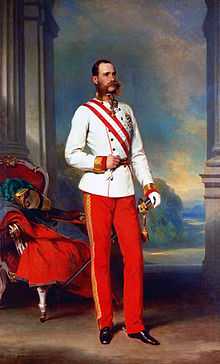 | Francis Joseph (Franjo Josip I.) | 2 December 1848 | 21 November 1916 | |
 | Charles IV (Karlo IV.) | 21 November 1916 | 16 November 1918 | Reigned until 1918, when he "renounced participation" in state affairs, but did not abdicate. He spent the remaining years of his life attempting to restore the monarchy until his death in 1922. |
Kings of Yugoslavia

House of Karađorđević
After the World War I and the break off of Austria-Hungary, Croatia joined a newly formed State of Slovenes, Croats and Serbs. Following a brief period of self-rule, became part of the Kingdom of Serbs, Croats, and Slovenes under the Karađorđević dynasty. In 1918 the title "King of Croatia" was united with other South Slavic monarchical titles into "King of Serbs, Croats and Slovenes". The name of the title was changed in 1929 amid unitarianist reforms to "King of Yugoslavia". Between 1939 - 1943 Croatia was an autonomous Banovina within the Kingdom of Yugoslavia, ruled by King Peter II, and administered in the King's name by Ban (viceroy) Ivan Šubašić. During this period, in 1941 Croatia was occupied by the Axis powers along with the rest of Yugoslavia.
| Portrait | Ruler | Began | Ended | Remarks |
|---|---|---|---|---|
 | Peter I (Petar I.) | 1 December 1918 | 16 August 1921 | Prince Alexander served as regent in his final years. |
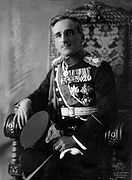 | Alexander I (Aleksandar I.) | 16 August 1921 | 9 October 1934 | Changed title to "King of Yugoslavia" in 1929. Assassinated in Marseilles. |
 | Peter II (Petar II.) | 9 October 1934 | 29 November 1945 | Succeeded while as a minor. Prince Paul of Yugoslavia served as regent until April 1941. Reigned from exile in London until deposed in November 1945. Ivan Šubašić served as Ban of the Banovina of Croatia (1939–43). The king was succeeded as Croatian head of state by Vladimir Nazor, the President of the ZAVNOH. |
Independent State of Croatia
1941 - 1945: the Nazi-puppet Independent State of Croatia was formed by the Axis powers on occupied Yugoslav territory, and was ruled by the Ustaše party led by Ante Pavelić. In May 1941 this state was made a formal kingdom (by agreement between Ante Pavelić and Benito Mussolini). Italian Prince Aimone, Duke of Aosta was formally named as the king-designate under the name "Tomislav II", but refused to assume the kingship, was never crowned, never ruled, and formally abdicated in 1943.
Post-monarchy
See:
See also
- List of rulers of Hungary for a list of monarchs between 1526 and 1918—mostly accurate for the Croatian lands
- Croatian Parliament
- Ban of Croatia
- History of Croatia
- Timeline of Croatian history
References
External links
- Monarchs of Croatia from Everything2
- The History Files: Kingdoms of Eastern Europe: Croatia
- WHKMLA History of Croatia, ToC
- Rulers of Croatia and Slavonia
- List of Croatian rulers PDF, University of Michigan
- List of Croatian Heads of State